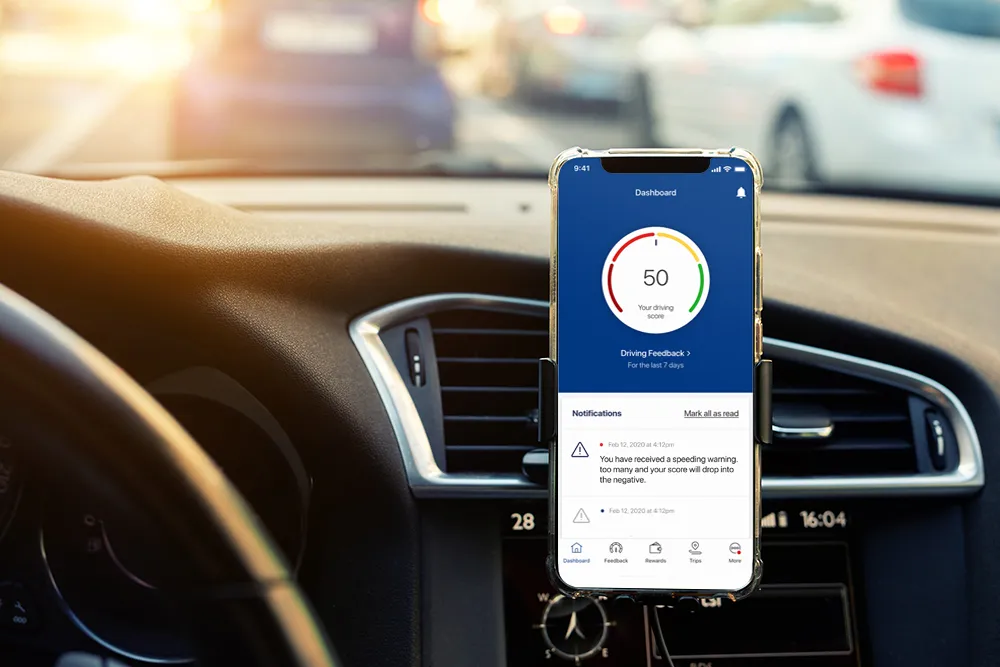The advantages of having access to driving data collected from mobile telematics have become increasingly clear and the prospective benefits have compelled many auto insurers to enhance their existing business operations to incorporate this technology. An enterprise project of this scope and scale requires an experienced guide—the right mobile telematics partner will outline the journey, provide pivotal implementation planning, deployment guidance, and help avoid missteps ensuring that the connected insurance program you implement will be an effective fit for your firm.
The three core stages of a successful mobile telematics program implementation include:
- Designing – Strategy and design decisions in the initial stages of a project will establish a course that lets you confidently move forward with financial considerations, an appropriate business framework, and a technology plan and roadmap firmly in place.
- Developing – The development stage is an opportunity to determine the solution components needed, the configuration specifications that will underlie the customization of the product, and to decide the overall structure of the customer experience. This is the execution phase of the project plan where the customer decisions are advanced to the actual implementation of the program.
- Deploying – The launch of a mobile telematics solution depends on the complexity of the elements included and the integration of components within the insurer’s IT infrastructure and business systems. At this stage, all the individual components of the program—tested and approved—are put together to ensure interoperability and seamless functionality.
A realistic timetable to complete these stages can be as early as four to six months for many companies, although depending on the complexity of the solution design, it may be slightly longer. The following sections summarize considerations for each of the three stages and offer recommendations for proceeding in an efficient and deliberate manner.
1. Design
Setting the Stage for a Successful Mobile Telematics Project
As you embark on the journey to incorporate mobile telematics technology into your auto insurance operations, take time to carefully consider and define the core ingredients of the planned solution. Gain a clear understanding of the challenges you are addressing in your organization and the desired outcomes. This is an area in which consulting with an experienced mobile telematics vendor will yield immediate and long-lasting benefits. The choices you make are crucial to success. Key considerations include forging a strategy that aligns with corporate objectives and can be smoothly integrated into your existing business workflow and IT framework. This stage is the time to take stock of your expectations, evaluate the financial issues involved, and shape the program features and capabilities from both a business operations standpoint and the customer experience that you want to deliver – for now and into the foreseeable future.
Assemble a Project Planning Team
For most programs, you will likely need to assemble a project team with members from two primary groups within the company:
- From the business unit that handles the insurance side of the business, likely candidates would be the Chief Financial Officer, Chief Information Officer, Chief Marketing Officer, Insurance Risk Director, and key staff members tasked with deciding how the customer experience and interface will be structured.
- From the Information Technology business unit, the likely participants to consider adding to the team are the Chief Technology Officer, Chief Security Officer, IT Director, IT system architect, and IT onsite support specialist.
Plan the Objectives for the Program
The objectives for your telematics program should dovetail with your corporate goals, factoring in these issues:
- Establishing a market position – As defined, will the program help achieve a boost in the market position desired? Have you also considered finer grain increases that may result in improvement in a particular segment of the market and within a given channel in which you compete (such as direct, agent, or broker)?
- Delivering a positive customer experience – Is the program structured in a way that will meet customer expectations and both attract and retain customers? Do your target customers favor competitive pricing, rewards programs, driver guidance, exceptional support, or specialized add-on features?
- Selecting an area for differentiation – Do you want to be recognized for technological expertise, actuarial expertise, strong communication capabilities, or another differentiator?
- Decide the scope of the mobile telematics effort – There are two core ways to collect data using mobile telematics. First, do you want to leverage your existing insurance policy app and use an SDK to integrate telematics, create a program and set its parameters? Or, secondly, do you want to design and/or configure a more specialized mobile app that delivers a more personalized user and program experience? The scope will affect the timetable and costs.
Set Up a Test Plan to Validate Proper Operation of the Program
Testing methodology to be used and individual responsibilities should be established during this stage. Both lab and field testing should be planned for and criteria set to define acceptable standards. Although it is important to establish a testing methodology during the first stage of the project, be willing to reconsider and modify test plans as the project progresses to reflect insights and information you gain during development.
Outline the Project Requirements
Based on what has been discussed so far, decide what will be required to implement the program, including staff members, solution components, external experts, and other assets. These aspects will help determine the next step: the operational budget for the project.
Determine the Operational Budget for the Program
Once you have come to an agreement on the scope and nature of the telematics program that you want to implement, evaluate the costs by looking at these factors:
- What are the monthly maintenance charges and service fees to operate the solution?
- Does the defined scoring model fit within the financial goals of the company?
- Are there any hidden costs or financial loopholes that may alter the revenue model?
- Is there an associated cost with add-on Bluetooth hardware?
Agree on Service Terms
The decisions made during this stage should be formalized in a commercial agreement and service-level agreement (SLA) to ensure both parties are clear on the requisite program elements.
With agreements in place—to the satisfaction of the insurance team and the telematics vendor—the actual work can be initiated to configure components, acquire any hardware add-ons if they are needed, and set up test configurations, as described in the next section.
2. Develop
Selecting and Configuring the Components for the Solution
This stage is where you can move from the high-level overview of the program and begin to clarify and configure the fine-grained details. As the active development work for the solution ensues, insurers should recast the project team, selecting staff members who can deal with the technical details of the program in collaboration with the mobile telematics vendor. Key factors and criteria that should be considered to ensure a successful implementation follow.
Set Up and Configure the Mobile Telematics-based Program
One of the most important aspects at this time is completing the steps necessary so that automatic trip recording can be quickly enabled for vehicles. Different configuration steps will be involved based on equipment and the smartphone app to be used. Certain tasks, however, are likely to be similar for all, including the following:
- Configuring the Features and Function for the Best Mobile Experience – Providing a solid and satisfying user experience is an important objective for a program. Be sure the process goes smoothly from a user’s point of view, from initial exposure to the program through the end results. A quality vendor will test the entire experience side-by-side with the insurer with a critical eye to how smooth the overall process is.
- Implementing Data Exporting and Integration Processes – The data generated by mobile telematics devices must be processed in several ways before it can be used by the system. Set up processes for capturing raw data, checking integrity, filtering and normalizing the data, and then disposing of it at the end of its lifecycle.
Ensure Security Provisions are Effective
Authentication of mobile telematics users, maintaining data privacy, and protecting against viruses and malware are essential for both meeting regulatory mandates and preserving customer privacy. Take steps to ensure that these important elements are part of the solution implementation.
Test and Then Retest
Pre-launch testing of the mobile telematics solution should be slated at this point. Members of the project team assigned this responsibility should test the operation of the solution components extensively before they are integrated into the overall solution. Simulation software can be useful at this stage to test a diverse range of configurations to detect errors or problems that might be difficult to replicate in an actual system. For example, simulation software lets you see if you have strong protection against malware and viruses on a mockup system, without risking the insurers’ or customers’ systems.
Establish Key Performance Indicators
Specify the key performance indicators (KPIs) that you want to use to determine the effectiveness of the telematics program. Run trials and test to ensure that the system is configured in a way that lets you measure and confirm that your results are delivering data that will help shape and refine the program once in operation.
Configure Advanced Engagement Components – Including Rewards or Loyalty Features
If rewards or loyalty programs are to be offered to customers to enhance the customer experience, configure the software app to enable these features and adapt the customer experience appropriately. Set up the tools and messages for communicating with customers when the official launch takes place in addition to the driving feedback received post trip. Configure and test the engagement tools at this stage, well in advance of the launch date.
As with other components in the program, test and retest to be sure the feature is working as expected. If done correctly, engagement tools and techniques help to drive true driving behavior modification while delivering an even more satisfying experience for policyholders.
Developing a Marketing Plan
A successful telematics program will require a marketing plan for rollout to customers. Start this early and expect to be involved in developing it for about 5 weeks.
3. Deploy
Integrate the Mobile Telematics Solution and Go Live
The results at this stage will determine how well you have accomplished the tasks in the earlier two stages. If everyone has done their work, the components should easily click into place, the integration work will result in smooth operations, and the testing regimen will have prefaced a flawless launch of the completed solution.
Complete the Integration Process
Perform a phased integration of components from the insurer’s policy systems to the mobile telematics app, including any add-on hardware. Ideally, a test sandbox can be configured to run trials and identify any problems or issues with the supporting systems and program configuration. If the insurer is using an SDK instead of configuring a new standalone mobile app, this may involve approximately 8 to 10 weeks to build and test the app.
Initiate Training As Needed For Staff Members
Make sure the administrators and support staff who will be overseeing the program are fully trained and conversant in the operation of the program. This includes routine maintenance and ongoing testing, as well as understanding how to engage fail-safe transitions in the event of server failures or hardware issues that arise.
Establish Testing Schedules and Guidelines
Once the program goes live, work with the mobile telematics partner to set up post-launch test reviews, install component updates on a regular basis, and obtain advice on scaling operations to accommodate increasing levels of data without system slowdowns or other issues.
Schedule Regular Consultations with the Partner
Expect that the program will need adjustment over the months that it is in operation. Schedule regular consulting sessions with the technology partner to discuss possible improvements to scoring, additional add-ons and options that may enhance the program, customer feedback that has been collected that may require resolution, and any other issues of merit. A reputable vendor will be prepared to engage over the full lifecycle of the program to make sure that it satisfies expectations and operates in a reliable manner.
Additional Resources
To learn more about launching mobile telematics programs, read more in the following blogs:
The Ultimate Introduction to Mobile Telematics
The Top 5 Best Practices for Mobile Telematics Success
Top Criteria for Selecting a Mobile Telematics Vendor
About IMS
IMS (Insurance & Mobility Solutions) is a vehicle and driving data business, delivering enterprise solutions to global insurers, mobility operators and governments. The IMS DriveSync platform provides the capability for customers to improve their approach to pricing, customer engagement, risk management and claims handling by leveraging telematics data from any source – smartphone apps, aftermarket hardware and OEM embedded units. The company, with offices across the UK, Europe and North America, has analyzed over 15 billion driving miles and its algorithms are fed by trillions of data points each day.
IMS is the only technology partner with direct-to-consumer insurance expertise having run a successful insurance arm, Carrot Insurance, in the UK. This served as a testbed for refining technologies and products, optimizing the effectiveness of solutions before launching them in the marketplace.
About the IMS One App
The success of any mobile telematics program depends in large part on the customer experience, much of which is necessarily delivered via a smartphone app. With IMS One App, you can offer a personalized experience tailored to product usage and the customer journey – offering true engagement that is proven to modify driving behavior.
IMS One App is a development framework that makes it quick and easy to create a mobile telematics experience that is proven to work, leading to measurably higher levels of engagement than apps created via other means. One App can help you truly connect with your customers, changing their driving behavior and delivering better outcomes, both for your business and for them.
Learn more about the IMS One App at https://ims.tech/oneapp/






